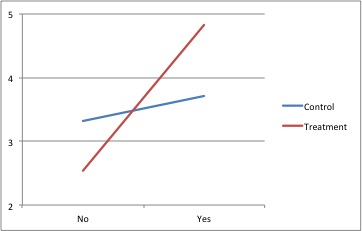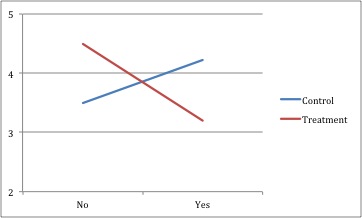Media Effects Research Lab - Research Archive
Meaningfully moved, but emotionally mixed
Student Researcher(s)
T. Franklin Waddell (Ph.D Candidate);
Stefanie E. Davis (Masters Candidate);
Faculty Supervisor
INTRODUCTION
Although non-hedonic motivations for media use have begun to receive more attention, less research has considered how exposure to meaningful media affects viewers’ enjoyment of other media content. Specifically, past research has yet to consider if viewers’ enjoyment of hedonic media is affected by feelings of elevation elicited by exposure to eudaimonic media. If the experience of elevation decreases viewers’ enjoyment of media violence, inducing elevation may be a possible intervention technique by which reinforcing spirals between viewers’ preferences for violent media content and subsequent aggressive behavior can be reduced.
RESEARCH QUESTION / HYPOTHESES:
Given the lack of previous research on how feelings of elevation affect viewers’ media preferences, the following research questions were proposed:
RQ1: For young adults, controlling for prior film exposure, what is the relationship between level of elevation and the degree of enjoyment elicited by exposure to media violence?
RQ2: For young adults, controlling for prior film exposure, what is the relationship between level of elevation and the degree of transportation elicited by exposure to media violence?
METHOD
To examine the relationship between level of elevation and viewers’ enjoyment of media violence, a two-condition between-subjects experiment was conducted. Participants were randomly assigned to view either a meaningful or non-meaningful film clip. After exposure, they rated their perceived degree of elevation and mixed affect on a post-exposure questionnaire. Then, all participants watched a violent media clip and evaluated their degree of enjoyment and transportation. Both clips were viewed in a dark room at a viewing distance of four feet on a 42in plasma screen television.
RESULTS
RQ1 (Enjoyment): No main effect of viewing condition on enjoyment was found, F (1,53) = .27, p = .605. However, a significant two-way interaction between viewing condition and prior exposure to the violent film clip was found, F (1, 53), = 8.66, p < .001. As shown in figure 1, participants in the treatment group with prior exposure to the violent film scored significantly higher in enjoyment (M = 4.82, SE = .377) than participants in the control group with prior exposure to the violent film(M = 3.71, SE = .352). By comparison, first time viewers of the violent film in the treatment group scored significantly lower on enjoyment (M = 2.54, SE = .234) than first time viewers of the violent film in the control group (M = 3.32, SE = .307).

RQ2 (Transportation): No significant effect of viewing condition on transportation was found, F (1, 53) = .000, p = .993. However, a significant two-way interaction between transportation and prior exposure to the eudaimonic filmon enjoyment was found, F (1, 53) = 11.84, p < .009. As shown in figure 2, participants in the treatment group with prior exposure to the eudaimonic film clipscored lower on transportation (M = 3.20, SE = .411) than participants in the control group with prior exposure the eudaimonic film (M = 4.22, SE = .403). Alternatively, first time viewers of the eudaimonic film in the treatment group scored higher on transportation (M = 4.5, SE = .30) than first time viewers in the control group (M = 3.49, SE = .351).

Path Analysis: Hayes’ PROCESS macro for SPSS with 5000 bootstrapped samples was used to test whether an indirect path from eudaimonic viewing to enjoyment existed through elevation, mixed affect, or transportation. Two significant indirect paths from viewing condition to enjoyment were found. As shown in figure 3, a negative indirect path from eudaimonic viewing to enjoyment through elevation was statistically significant (b1 = -.783, SE = 334, LLCI = -1.52, ULCI = -.174). In addition, a positive indirect path from eudaimonic viewing to enjoyment through elevation, mixed affect, and transportation was also found that was statistically significant (b4 = .267, SE = .149, LLCI = .056, ULCI = .687).
DISCUSSION/ CONCLUSION
The results of the present study found that elevation has a dual effect on viewers’ enjoyment of media violence. Specifically, two indirect paths from meaningful media exposure to enjoyment were found, as elevation was negatively correlated with enjoyment whereas mixed affect and transportation were positively correlated with enjoyment. Furthermore, participants’ prior exposure to the violent film clip used in current study moderated the effect of meaningful media exposure on enjoyment. For first time viewers of the violent film, viewing the meaningful film decreased their enjoyment of media violence. However, for repeat viewers of the violent film, exposure to the meaningful film clip increased their subsequent enjoyment. In other words, the effect of elevation on viewers’ enjoyment of media violence varied based on their prior viewing of the violent film in question. Based on the results of the current study, it appears that inducing feelings of elevation is limited as a means of altering viewers’ pre-existing media preferences.
For more details regarding the study contact
Dr. S. Shyam Sundar by e-mail at sss12@psu.edu or by telephone at (814) 865-2173

